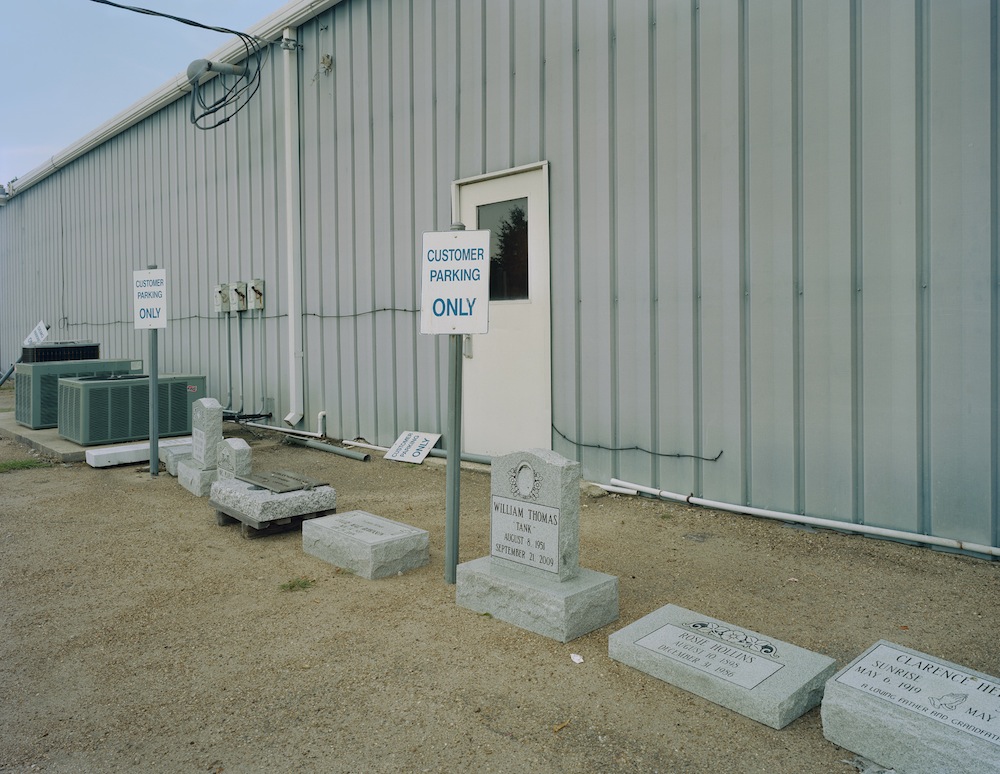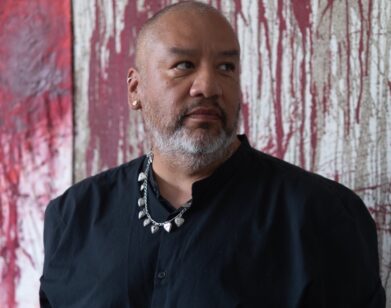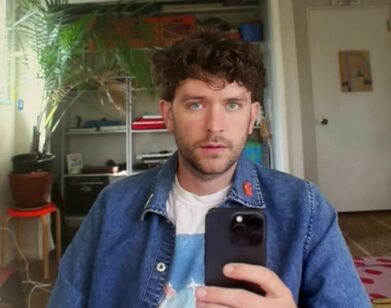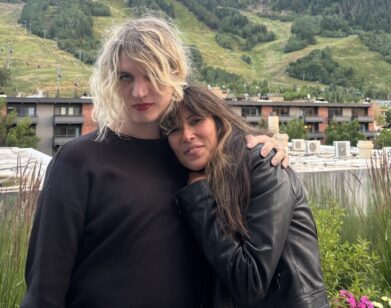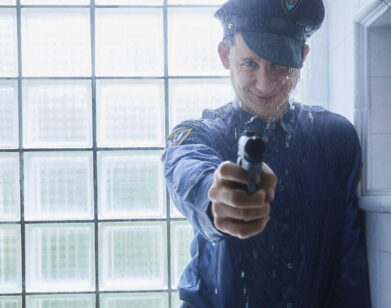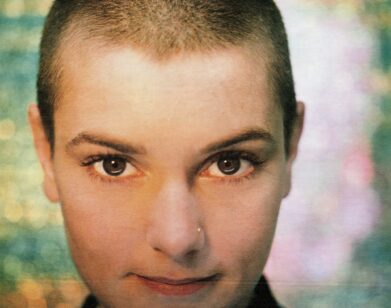Timothy Hursley’s Architectural Eye
Timothy Hursley began photographing architecture at age 16. What started out as a series of small jobs for his Detroit neighbor, artist Balthazar Korab, became a nine-year apprenticeship, and then a lifelong pursuit. He’s documented exteriors, interiors, (and sometimes, their inhabitants) for decades, from Philip Johnson’s AT&T building in New York to Frank Gehry’s Guggenheim Museum Bilbao in Spain and our magazine’s former offices at Andy Warhol’s Factory.
Hursley’s work captures the emotion in structures; he balances light and space with angles that tell the stories of his myriad subjects. Throughout his career, he’s done both commercial work and series of his travels in the U.S., including photographing brothels in Nevada, polygamist communities in Utah, and funeral homes in the South. He found himself at Interview in 1982, when Progressive Architecture commissioned him to photograph Andy Warhol’s Factory on 34th Street and Madison Avenue. He regularly visited until Warhol’s death in 1987, capturing our office’s development and taking portraits of our founder and his crew of artist and celebrity friends throughout the years—some images of which have never before been published, and are featured here for the first time. A wide range of Hursley’s work, which includes some of these never-before-seen works, is also on view at Garvey|Simon gallery in New York through June 10 in an exhibition titled “Timothy Hursley: Tainted Lens.”
Here, Hursley discusses how he became an architectural photographer, his subjects, and photographing the Factory.
CEDAR PASORI: What were the first architectural photographs that moved you and made you want to get into this genre of photography?
TIMOTHY HURSLEY: The first one was Edward Steichen’s photograph of New York’s Flatiron Building in the rain and fog with transparent winter trees. It has a magical quality that made a deep, deep impression on me.
PASORI: You had a fruitful apprenticeship early in your career. Did you ever consider another career path, or did that job reassure you to continue?
HURSLEY: At the time of my first apprenticeship, I was 16 years old and still in high school. I accepted a job doing yard work for the Hungarian architectural photographer, Balthazar Korab. Eventually, I was brought into the studio, which was in an old barn at his home in the suburbs of Detroit. While all of my high school friends went off to universities, I stayed in Detroit and learned about photography and architects with Korab. I really had no concept of being in college and didn’t keep in touch with my former classmates. Slowly I developed an interest in photography. I never considered anything else.
PASORI: Who are some photographers you’ve looked up to along the way?
HURSLEY: Some names are Clarence John Laughlin, Andreas Gursky, Joel Peter Witkin, and Joel Meyerowitz. I was in downtown St. Louis in 1980 when I saw a poster of a Joel Meyerowitz photograph. It was a detail of the base of Eero Saarinen’s arch shot at night. His collection of photographs reaffirmed my interest in architecture in context. I like his use of informal compositions, color, and wit.
PASORI: Is there any advice that stuck with you or helped you define your style throughout the years?
HURSLEY: Back in Detroit, as I was heading off to shoot the Corning Museum of Glass for the architect Gunnar Birkerts, an early mentor of mine gave me the directive, “No cornball shots.” I interpreted that to mean don’t take any “typical” shots. Other photographers told me that I should find a series to focus on for non-commissioned work. That led me to my first series of the Nevada brothels.
PASORI: How do you approach the work you get commissioned to do by architects versus your personal work in-between assignments?
HURSLEY: The commissioned work is more strenuous with long hours; I pretty much start before dawn and stop just beyond dusk. I try to stay ahead of the light, following the sun play on the building, inside and out. I like to focus on the abstract quality and luminous surfaces of contemporary architecture.
With my personal work, I’ve noticed that I prefer overcast days when shooting landscapes. It allows for more possibilities. I have a more relaxed search for light and rely more on content and irony.
PASORI: How did you get drawn to various subcultures in the U.S., particularly the funeral homes in the South and the polygamists in Utah?
HURSLEY: I first learned of the polygamists in Utah while watching CNN reports about Colorado City, the capital city of polygamy. The reporting seemed very confrontational. I noticed walled-off streets in the background, which made me wonder what the architecture of polygamy would look like.
I then arranged for a tour of Colorado City with a local apostate. I found so many layers to work with and began documenting the facades of homes that were lived in but left intentionally unfinished as plywood forms. I was taken to an abandoned zoo and told that Warren Jeffs had sold all of the animals. I found a number of interesting vernacular cages there, including one that seemed matronly; it looked like a woman’s hoop skirt. There was a park with enormous cottonwood trees and homemade playground equipment. On the second evening, I was shown a cave in the mountain overlooking the town. It had various chamber and tunnels, some containing jars of fruit and vegetables that had been there for years. There was no electricity, so we purchased strong flashlights at the lone hardware store in town to light up the cave interior. I went on to visit wherever I could find polygamist settlements in Utah. I set about documenting the Nevada brothels in a similar way.
My interest in funeral homes began in Helena, Arkansas. I had made a trip to look at the flooded Mississippi River. As I drove through the nearly abandoned downtown, I noticed two old white hearses under a canopy. I then began to search for funeral homes during trips in the rural south, pulling out my iPhone to ask for “funeral homes near me.” Nine out of 10 aren’t interesting, but in general I’ve been finding a new southern landscape of abandoned hearses, limos, and closed funeral homes.
PASORI: What drew you to the Alabama Silo in 2008, and why did you stick with the series for 18 months?
HURSLEY: I was on Highway 14 between Marion and Greensboro, a part of Alabama I had been traveling through since I began photographing the buildings of the Rural Studio, an architecture program of Auburn University. It was in early spring, so there was a transparency in the landscape. I noticed an enormous crumpled metal object way across a field. I got up closer and was taken by this twisted metal silo. It had an otherworldly look. I learned that it had been twisted by a tornado years back. I looked at the silo as sculpture. Every angle brought out another portrait. I felt that I had discovered an object from The War of the Worlds frozen in time, a soldier that had been dropped from space.
Whenever I was back in Hale County for the Rural Studio, I would check out the silo. During one visit, I learned that it was going to be scrapped for the metal. I was convinced that it was sculpture and began to think that it should be moved to somewhere, preferably New York City. The owner agreed to not scrap the silo, and within a few months I acquired it.
I then began to share the photographs of it and wanted to take more without having to be there. I mounted a surveillance camera in the field, with one view shooting a frame every 30 seconds, day and night. After retrieving my first set of images from the hard drive a few months later, I was thrilled about a storm that had happened one night. I then decided to increase the shooting to every 12 seconds, and I installed two LED lights to light the silo. As the camera was running, shooting every 12 seconds, I would be back in Little Rock, watching and cheering for storms as they rolled through Hale County.
I liked the idea of the surveillance camera so much that I set one up on a grain elevator in Gould, Arkansas and another at an abandoned steel mill in Ensley, Alabama. At one time I had three cameras going in two states shooting 30,000 frames a day.
PASORI: Talk about the experience of photographing the Interview offices in the ’80s.
HURSLEY: In 1982, I was living in Little Rock, Arkansas when I got a call from Progressive Architecture to photograph Interview magazine’s offices located in Warhol’s new Factory at 34th and Madison. The Interview offices were at the 33rd Street entrance. Pieces of the magazine were in layout, and images of pop culture were everywhere throughout the space.
I soon discovered that the Interview offices were one part of the old Con Ed building that Warhol had purchased for his new Factory. The footprint was T-shaped with three entrances and three floors of cavernous spaces. At that time, the Interview space was the only one that was finished. The Madison Avenue entrance was still unoccupied and raw. The 34th Street entrance was a gathering space for Warhol’s possessions as they were moved into the building. Fred Hughes’ upstairs office overlooking the 34th Street lobby entrance was painted red but only contained a desk. Vincent Fremont’s office was on the ground floor between Interview and the building’s other two arms. On an upper floor, there was a large room with huge skylights, which seemed to be a boardroom but later became Warhol’s painting studio.
I made my way down to the basement and discovered an all-white space that was empty except for an old school desk. There, I took a few abstract portraits of Andy Warhol. I met Fred Hughes, Interview‘s publisher, and Vincent Fremont, another business associate of Andy’s. I think Fred liked that I was an architectural photographer and had taken an interest in the spaces as they were being developed in the early stages of Warhol’s latest Factory. Each time I was back in New York, I would call Fred or Vincent and come by the Factory to take a new set of photos, mostly of the studio side since it was constantly changing. The renovation of spaces kept getting closer to completion, and Warhol’s collection and art began to move through. I continued to document the Factory up until Andy’s death in 1987.
PASORI: Are there any particular Warhol memories that stick out to you?
HURSLEY: I had photographed the stark white basement of the Factory on an earlier trip, and had imagined the space as the background of an abstract portrait with Warhol. Andy got in the frame and seemed completely aware of his pose. He was wearing boots, blue jeans, and a black turtleneck. About the only thing he said was that he liked my pictures.
Another day I was there at the Factory with my view camera. I was told that I could stay and shoot. Some of the guests there included Andy, Keith Haring, Bianca Jagger, Quentin Crisp, Boy George, Rupert Everett, and Andy’s personal trainer. It was a mostly British group. I set up my camera at one end of the table and asked everyone to look my way and hold still as I exposed sheet films. I can’t remember who, I think Bianca Jagger, said, “Do we look monumental?”
“TIMOTHY HURSLEY: TAINTED LENS” IS ON VIEW AT GARVEY|SIMON IN NEW YORK THROUGH JUNE 10, 2017. FOR MORE ON TIMOTHY HURSLEY, VISIT HIS WEBSITE.

